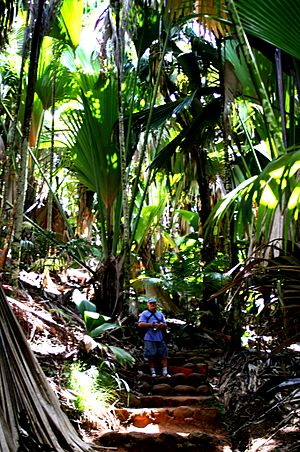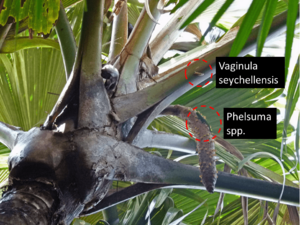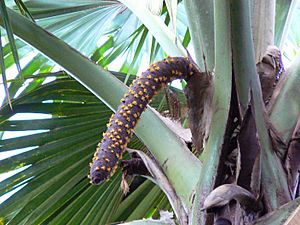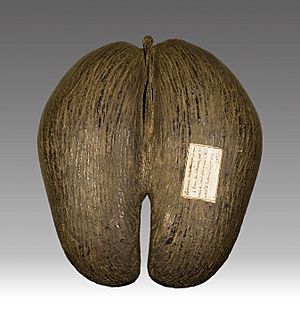Sea coconut facts for kids
Quick facts for kids Sea coconut |
|
|---|---|
 |
|
| Habit, with fruit | |
| Conservation status | |
| Scientific classification | |
| Genus: |
Lodoicea
|
| Species: |
maldivica
|
| Synonyms | |
|
List
|
|
The Lodoicea palm, also known as the sea coconut, coco de mer, or double coconut, is a special type of palm tree. It's the only species in its group, meaning it's truly unique! This amazing tree only grows on the islands of Praslin and Curieuse in the Seychelles. It's famous for having the biggest seed of any plant in the world.
Long ago, this palm also grew on smaller islands nearby, like St Pierre and Ile Ronde. But it disappeared from those places. Luckily, people have recently started planting it there again to help it grow back. The name Lodoicea might come from "Louis," honoring King Louis XV of France. Some say it's named after Laodice, a princess from ancient stories.
Contents
About the Coco de Mer Palm
The coco de mer tree usually grows to be about 25–34 meters (82–111 feet) tall. The tallest one ever measured was an amazing 56.7 meters (186 feet) after it was cut down! Its leaves are shaped like a fan and can be 7–10 meters (23–33 feet) long and 4.5 meters (15 feet) wide. The stem that holds the leaf, called a petiole, can be 4 meters (13 feet) long on grown-up plants. Young plants can have even longer petioles, up to 10 meters (33 feet)!
These trees have separate male and female plants. The male flowers grow in a long cluster, up to 2 meters (6.5 feet) long. This cluster can keep producing pollen for ten years, which is one of the longest times known for any flower cluster!
The Amazing Fruit and Seed
The fruit of the coco de mer is huge! It's about 40–50 centimeters (16–20 inches) wide and can weigh 15–30 kilograms (33–66 pounds). Inside is the largest seed in the entire plant kingdom. This fruit takes a very long time to grow, about 6–7 years to fully ripen. After it falls, the seed takes another two years to sprout! People sometimes call the fruit the "sea coconut," "love nut," or "Seychelles nut."
The coco de mer palm is special because it has many unique features. It's known for:
- Producing the largest wild fruit, weighing up to 36 kg (79.2 lbs), and sometimes even 45 kg (99 lbs)! (Though some farmed pumpkins and watermelons can be heavier).
- Having the world's heaviest mature seeds, weighing up to 17.6 kg (38.8 lbs).
- Growing the longest known first leaf (cotyledon) when it sprouts, up to 4 meters (13 feet) or even 10 meters (33 feet) long.
- Being one of the slowest-growing large trees. It grew only about 33 millimeters (1.29 inches) per year over 140 years in one garden.
- Having the largest female flowers of any palm, up to 10 centimeters (4 inches) wide.
- Producing the longest male flower clusters (catkins), up to 2 meters (6.5 feet) long.
- Having the largest sepals (leaf-like parts that protect the flower), which grow with the fruit and can be 23 centimeters (9 inches) long.
- Having leaves with the longest lifespan of any monocot plant. They take nine years to grow and then work for nine more years. Some adult trees can have leaves that last up to 24 years!
- Being the best plant known for getting nutrients back from its old leaves.
Unlike most palms, the coco de mer has separate male and female plants. This means you need both a male and a female tree for seeds to be made.
How the Tree Grows
The Lodoicea palm is strong and grows alone, reaching up to 30 meters (98 feet) tall. Its trunk is straight and has rings from where old leaves fell off. The bottom of the trunk is shaped like a bulb and fits into a natural bowl in the ground. This bowl has many small holes where the roots grow out into the soil. The roots are a bit stretchy, which helps the tree sway slightly in strong winds without breaking.
Leaves of the Palm
The top of the tree has a thick crown of stiff, fan-shaped leaves. They can be up to 10 meters (33 feet) wide, with stems (petioles) that are 2 to 4 meters (6.5 to 13 feet) long. The leaves are folded at the base and split into segments. These huge leaves act like a funnel, catching things like pollen that fall from the sky. When it rains, the water washes these materials down to the base of the trunk. This helps the Lodoicea palm get more nutrients, which is especially important for its seeds.
Flowers and Pollination
The male flowers grow in spirals and are protected by tough, leathery covers. Each male flower has small parts that form a tube and petals. They have 17 to 22 stamens, which produce pollen. The female flowers grow alone along a zig-zagging stem. They are egg-shaped with three petals and three sepals.
Scientists think that animals like the bright green geckos and white slugs that live in the forest might help pollinate the flowers. Wind and rain are also thought to be important for pollination. It's only when the Lodoicea palm starts to produce flowers, which can take anywhere from 11 to over 45 years, that you can tell if it's a male or female plant. The nectar and pollen also provide food for several local animals, including geckos, slugs, and insects.
The male flower clusters are long, like catkins, measuring 1 to 2 meters (3 to 6.5 feet) long and about 8 centimeters (3 inches) wide. They can produce pollen for 8 to 10 years! These clusters usually grow at the very top of the plant, sometimes one, sometimes two or three. The female flower clusters are also 1 to 2 meters long and have flowers growing on a zig-zagging stem.
The Fruit and Seed
The fruit is shaped like two connected lobes, flattened, and 40 to 50 centimeters (16 to 20 inches) long. It usually has one seed inside, but sometimes two to four. The outside skin is smooth, and the middle part is fibrous. The inside of the seed is thick, hard, hollow, and smooth. The tiny plant embryo sits in the dip between the two lobes. When the seed sprouts, a long tube grows out, connecting the young plant to the seed. This tube can reach about 4 meters (13 feet) long, and in the Vallee de Mai, it can be up to 10 meters (33 feet) long!
People once thought the coco de mer was a "sea-bean" that floated across the ocean to spread its seeds. However, we now know that a healthy, viable nut is too heavy to float. Only nuts that have rotted and become hollow can float on the sea. This explains why these trees are only found on two islands.
Where the Coco de Mer Lives
Lodoicea palms live in rainforests where the soil is deep and drains well, often on open, sloped areas. However, they don't grow as well in eroded soils.
History and Legends
Long ago, the Lodoicea palm was called the "Maldive coconut." This name came about before the Seychelles islands were settled in the 1700s. For centuries, coco de mer nuts that fell into the sea would float eastward with the ocean currents. But remember, only rotted, hollow nuts can float. Many of these floating nuts ended up in the Maldives, where people collected them from beaches. They were highly valued as important items for trade and medicine.
Before the true source of the nut was discovered in 1768 by Dufresne, many people believed these mysterious nuts grew on a mythical tree at the bottom of the sea. In the 1500s, rich European nobles would often have the shells of these nuts polished and decorated with expensive jewels. They kept them as special treasures in their private collections. Today, the coco de mer tree is a very rare and protected species.
How People Use the Coco de Mer
The coco de mer tree is grown as a beautiful ornamental tree in many tropical places, like botanical gardens in Sri Lanka and Thailand. New groups of these trees have also been planted on Mahé and Silhouette Island in the Seychelles to help save the species.
The fruit is used in different types of traditional medicine, including Siddha medicine, Ayurvedic medicine, and traditional Chinese medicine. In cooking, especially in southern Chinese food like in Guangdong Province, it's used to add flavor to soups.
The seeds of Lodoicea have been very valuable for hundreds of years. Because they were so rare, they were highly sought after and sold for high prices in royal courts. The tough outer shell of the seed has also been used to make bowls, like the kashkul bowls used by Sufi/Dervish beggars, and other tools. In traditional Chinese medicine, it's used to help with inflammation, nausea, and abdominal pain.
Palm Family Tree
The Lodoicea palm belongs to a group of palms called Coryphoideae and a smaller group called Borasseae. There are seven types of Borasseae palms around the world. Four of them are found in Madagascar, and one, the coco de mer, is in the Seychelles. These palms are found along the coasts of the Indian Ocean and on islands within it. The Borassus palm, which is the closest relative to Lodoicea, has about five species found in Africa, India, Southeast Asia, Malaysia, New Guinea, and Madagascar.
Threats to the Coco de Mer
The Lodoicea maldivica is officially listed as an endangered species by the International Union for the Conservation of Nature (IUCN). In 2019, there were only about 8,000 wild adult trees left. People have collected the nuts for so long that it has almost stopped new trees from growing naturally, except for the trees planted on Silhouette Island. This palm has already disappeared from the wild on three other Seychelles islands where it used to grow.
Losing its natural home is one of the biggest dangers to the remaining trees. There have been many fires on the islands of Praslin and Curieuse, and in large areas of these islands, only young trees are left.
Saving the Coco de Mer
The Seychelles is a World Heritage Site, and one-third of its land is now protected. The main groups of Lodoicea palms are found within the Praslin and Curieuse National Parks. The buying and selling of the nuts are controlled by a special law from 1995 called the Coco-de-mer (Management) Decree. Firebreaks (clear areas to stop fires) are also made in important places to prevent big fires from destroying the palm populations.
Coco de mer palms are also grown on other islands and are common in botanical gardens. However, collecting seeds to grow these new groups might actually be another threat to the wild trees that are left. To protect this amazing palm, it's important to keep protecting the existing groups, make sure the rules are followed, and control fires effectively. In 2015, a single cultivated plant at the Botanical Garden of Kolkata in India was successfully pollinated by hand, which was a big step for conservation.
Gallery
-
A kashkul bowl with a portrait of dervishes and a falconer, from the year 1280 in the Islamic calendar. This one is in the Brooklyn Museum.
See also
 In Spanish: Lodoicea maldivica para niños
In Spanish: Lodoicea maldivica para niños










